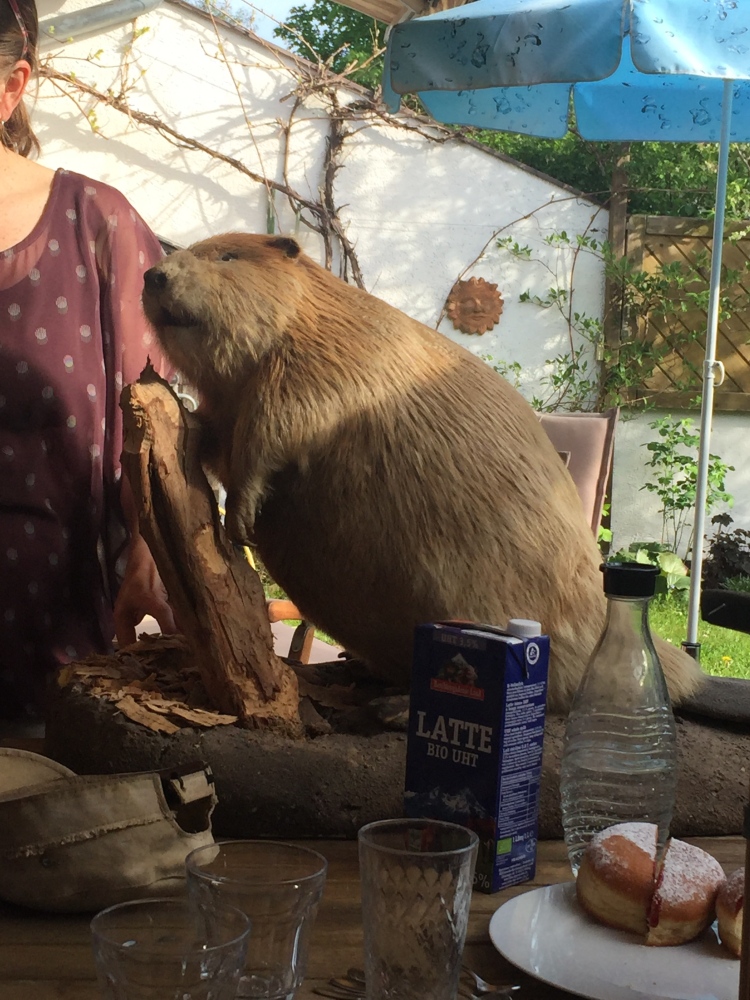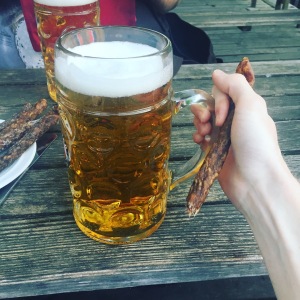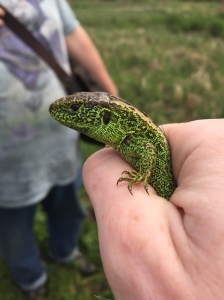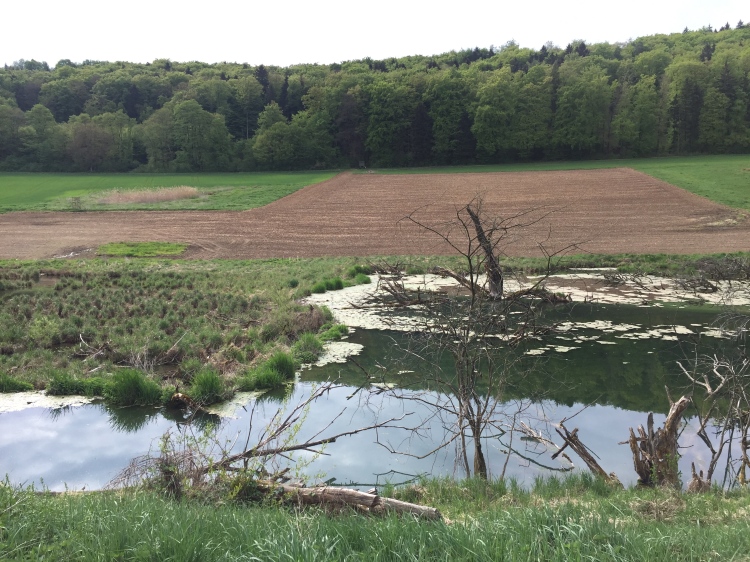
Disclaimer: This was the closest thing seen to a live beaver over the course of the trip.
For most, Bavaria brings to mind beer. Having visited this region of Germany back in April I can confirm that’s apt. I’ve been well converted to the wheat beer and schnitzel, and after five evenings of sampling half of the region’s output of these goods with my seven companions for the trip, by the end of it all my head felt not unlike it had been on a stag-do.
While Bavaria’s beer is its notable export, something brought into the region – or rather brought back – is in fact more fascinating than the bevvies, and it doesn’t even give you a hangover (I think). They are the industrious, second-largest rodents we all know and love or loathe, depending on your perspective – the beaver.

Not just about the beer
Following their reintroduction in the 1960s, from a few small areas they have recolonised more or less every watercourse. Bear in mind that the Bavarian landscape is by no means a wild one where big beasts roam free and chase the colours of the wind. It is often flat, and full of intensive agriculture. Essentially it’s Norfolk with Germans. And many of them were not too pleased when de Biber started blocking drainage ditches, felling prize trees and burrowing into the fields, potholing tractors as they did so.
Many called for the beaver to be eradicated, and it could well have gone that way. But there was a concentrated effort to mitigate the beaver’s habits were it became a problem to human interests, while very much allowing the animal to colonise Bavaria.
Funnily enough, we in Britain are at the point the Bavarians were half a century ago. With two publicly known free-living colonies in Devon and Tayside, and numerous ‘covert’ ones elsewhere growing in number, they’re here to stay. The question is whether we decide to be grown up about this and take a leaf out of the Bavarians book, or have entrenched camps continue to bicker eternally while beavers become subject to unofficial ‘control’.
This trip was a chance to see how it was done, and what we could learn from the Germans as we pave a future for British beavers. A party consisting of representatives from the Country Landowners Association (CLA), the University of Exeter, the Forestry Commission and myself were lead by two folk who have become inextricably linked to the animals. Derek Gow has been at the forefront of bringing these animals back to the UK since the 90s, and also happens to be my new boss. The other was his Bavarian counterpart, Gerhard Schawb. A mighty blend of huge, ancient shaman and a hint of hippy – his chest-length white hair tucked up behind a head-band gives the air of a Santa Claus who went to Woodstock and never left – he has been championing the beaver in Bavaria since the beginning.
As if to prove a point on how intertwined these animals can become with people, upon arrival Gerhard took us to the centre of a large town with a small river flowing through its centre. Sure enough, alongside pavements, playgrounds and office blocks, were beaver feeding signs on the riverbank, continuing all the way into an urban park with dogs, children and cyclists blending right into the beavers territory. One thing is for certain – these are not animals purely of wildland, and give them water and food and they will turn up anywhere.

Wire-guarded tree to protect from beaver gnawing in an urban park.
Of course the wilder protected areas still host beavers, but this doesn’t mean they keep out the way of humans. Our next visit was to what was once pony fields in the bottom of a valley nestled within the Bavaria Forest National Park, loomed over by pine-clad hills. This was the first of several sites where we learnt quickly that if you have flat land and beavers, all of the former would be reclaimed sharpish.
Dams conjured pools fringed with sedges, engulfed around both dead and decaying trees and, in cyclical beauty, the new coppiced growth. Silted-up meadows and re-wetting marsh meld interchangeably in shifting shades of green, and was all the more beautiful for it. The closest comparison I could think of was the edges of Kenyan great lakes like Naivasha and Nakuru, unmanaged besides the grazing of hippos. This only served to make British attempts at wetland ‘management’ – often just reedbed monocultures – all the more under-cooked for it. A recent study showed beaver wetlands in Scotland were restoring vegetation communities long since lost from Britain1, and this was a clear illustration as to what they were.

Beaver-generated wetland in what was once horse fields.
Even in the wetlands that don’t appear so heavily modified by beavers, their traces are readily evident. Another site we visited was a nature reserve of ditches, fen and reedbed on the banks of the Danube, not unlike many of the popular British spots such as Minsmere. Lodges, feeding piles and even scent mounds (which smell not unpleasantly metallic) interweaved among marked footpaths and signage.
While the reserve and most of its visitors sing the beavers praise, you’ll never get a world where everyone thinks the same as you. “If I could get rid of all the beavers here with the press of button, I would” said the head of the local farmers union to us. But he still tolerates them, and that is the key.
We met him and another farmer on the latter’s land, where the local beavers had been relocated after causing problems through their burrowing activities. As the beavers move further into the bank, this causes soil collapse on the surface and can be a hazard for tractors and livestock. To get a sense of how dramatic this can be, dredging of the creek had exposed the beavers’ burrow; while I’m far from the stockiest 24 year-old in the world, I would have been reasonably able to crawl inside.

Dredged stream banks exposing the beaver burrows
As the issue couldn’t be resolved with any of the available mitigation methods, relocation to a suitable site elsewhere was the next step. In cases where this is not possible, humane euthanasia is the final resort. While over a thousand beavers are killed annually in Germany, this is still a very small percentage of the population. These animals had obviously been a cause of exasperation for both farmers, made clear after he finished our conversation with a jovial “good luck to you!” But unlike farmers working similar landscapes by Scotland’s River Tay today who happily undertake ‘cowboy’ beaver extermination to the detriment of its populations, here they will at least ‘put up’ with the animals as they know there is an effective management plan in place should things become difficult, while allowing the beaver population to expand naturally. If we can reach that attitude across Britain we’ll have accomplished a huge step.
Much of this has been a result of volunteer beaver consultants that can be found in nearly every town and village. One such example is Jügen Roith, who we had the pleasure of being introduced to. A chatty and charismatic man, he also happened to be the mayor for the town of Winzer – all key traits for diplomacy that’s essential if you’re going to be facing wildly differing views on beavers.

Hastily leading us towards six-foot dams beaver-felled trees in the middle of woods while still wearing a trim suit (having come straight from work), he is an invaluable link in ensuring any arising beaver conflicts can be swiftly nipped in the bud. One common complaint about environmental advisory services in the UK is the sheer amount of time, bureaucracy and money involved to get anything resolved. The key difference with beaver consultants like Jügen is a very quick response turnaround (within the day or day after), with precise knowledge of what mitigation if any is required, all funded by local authorities. On top of that, he is respected and most importantly, trusted. With that key ingredient, a broad range of stakeholders who might otherwise have held ill feelings toward beavers will take his word seriously.
While the great environmental changes brought on by beavers may not be appreciated by some who work the land, for other wildlife the beaver is positively God-like in its ability to sculpt new paradises. This now widely known concept is one of the key things that hooked me on the idea of bringing these beasties back to Britain in the first place, and spotting what other birds, amphibians or insects were cavorting around beaver dams had become a highlight of the trip. One site in particular highlighted the beauty in this unpredictability.
Accompanied by local ecologist Uli MeBlinge, it was another strip of what was once flat farmland now completely engulfed by beaver-engineered wetland – dead trees standing in water, ponds the size of Olympic swimming pools, complex meadows of rushes and reeds, the whole lot. As we ambled through the dewy tussocks of the latter, Derek pointed out a startling creature I promptly caught in true schoolboy naturalist fashion. It was a male sand lizard, vibrant green as a freshly mown lawn.

Male sand lizard caught in a beaver wetland.
This was actually the second individual we had caught close to a beaver dam on this trip, having found a female two days before, but even more curious is the fact that most British herpetologists would probably tell you a boggy beaver wetland is just about the polar opposite of where you ‘should’ find this lover of sandy heaths and dunes. ‘Over-specialisation syndrome’ is a classic trait of many British naturalists brought on by a skewed view of how species should live their lives in our fragmented countryside as if they were reading a script, and the Bavarian sand lizards are just one of many animals that change the rule-book when beavers arrive.
With the coming of the beaver, there were fears the valuable golden-ringed dragonfly population would vanish in the absence of the fast flows they apparently loved. Turns out the variation provided by the beaver pools were much better, and the dragonfly numbers have gone up. Red-backed shrikes are commonly thought of as birds of dry scrub and heath, but there are just as many grasshoppers in beaver meadows – so there are now 6 pairs breeding within this small valley.
A current topic of debate among conservationists in the UK is just how much open-type habitats existed prior to agriculture, and where ‘farmland’ species found their niche. Having seen what a few giant aquatic squirrels can create in Bavaria, I was increasingly convinced that networks of beaver wetlands in the floodplains would have provided a big part of the answer. It struck me that the habitat was perfect for curlew, a species in Britain which now has its strongholds in upland moorland; an artificial habitat frequently kept that way for grouse shooting. Meanwhile, its former lowland haunts are more or less gone through land use change. Subsequently, this species finds itself a poster bird in increasingly polarised debates over the former’s sustainability. Long-term, could the hope for this species’ future in fact lie with the beaver? What other on-the-brink species in Britain – perhaps the mole cricket, the natterjack toad, the willow tit – could find salvation in these habitats?

The incredible beaver wetland shown to us by Uli. All flat ground was once a stream surrounded by farmland. Now the latter is based on the sloping aspect.
Ultimately however, dwelling on single-species framed arguments for beaver restoration is probably not the best way to look at it. After all, the various critters that pay rent to these animals will probably change over time with the landscape. But it’s very telling how the random ecological engineering that would have been going on for millennia restores life at riches that can be challenging for human managers to recreate.

Beavers had also helped create this flooded forest beloved of woodpeckers and amphibians. Typical of Bavaria, while this looks to be a remote, wild location, it is right on the edge of suburbia. Note the white stork in nest in the foreground.
Our final beaver site visit was literally just before we flew off home, because it happened to be right next to Munich airport. As we stood there close to beaver-felled willows which the local roe deer had been using as scent-rubbing posts, the laughing quack of the pool frogs as enthusiastic as DJs competed with the roars of the frequent departure flights to epitomise what my perception of Bavaria had been – an eccentric and wonderful merger of the mundane and the magic. Derek frequently says that beavers “literally breathe life back into landscapes”. I had been spoilt by the number of times I had seen this over the last week.
As we arrived back at Heathrow, myself and CLA Chris both noted how we’d gazed down at the capillaries of streams and tiny rivers slithering around the M5 commuter-belt on our descent, and squinting to picture the beaver dams that could one day sit inside them, breathing back that life. I certainly hope it doesn’t take too long.

References
- Law, A., Gaywood, M. J., Jones, K. C., Ramsay, P., & Willby, N. J. (2017). Using ecosystem engineers as tools in habitat restoration and rewilding: beaver and wetlands. Sci. Total Environ. 605, 1021-1030.
Pingback: Bringing back the Beaver: Wading to magic through bureaucracy | Pete Cooper Wildlife